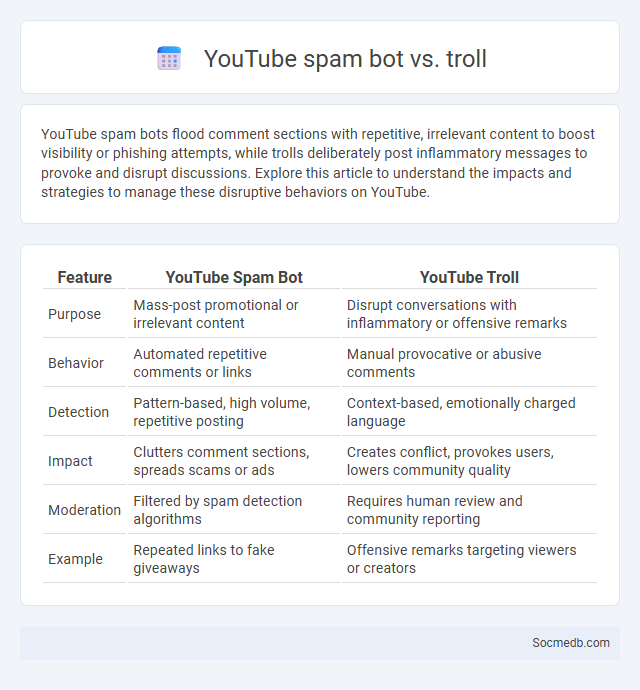
Photo illustration: YouTube spam bot vs troll
YouTube spam bots flood comment sections with repetitive, irrelevant content to boost visibility or phishing attempts, while trolls deliberately post inflammatory messages to provoke and disrupt discussions. Explore this article to understand the impacts and strategies to manage these disruptive behaviors on YouTube.
Table of Comparison
| Feature | YouTube Spam Bot | YouTube Troll |
|---|---|---|
| Purpose | Mass-post promotional or irrelevant content | Disrupt conversations with inflammatory or offensive remarks |
| Behavior | Automated repetitive comments or links | Manual provocative or abusive comments |
| Detection | Pattern-based, high volume, repetitive posting | Context-based, emotionally charged language |
| Impact | Clutters comment sections, spreads scams or ads | Creates conflict, provokes users, lowers community quality |
| Moderation | Filtered by spam detection algorithms | Requires human review and community reporting |
| Example | Repeated links to fake giveaways | Offensive remarks targeting viewers or creators |
Understanding YouTube Spam Bots: Definition and Behavior
YouTube spam bots are automated programs designed to post irrelevant or harmful content, such as fake comments and misleading links, on videos to manipulate engagement metrics and spread malicious information. These bots use sophisticated algorithms to mimic legitimate users, making it difficult for YouTube's detection systems to filter them out effectively. Understanding YouTube spam bots helps you recognize suspicious activity and protect your channel from potential harm.
What is a Troll on YouTube? Key Characteristics
A troll on YouTube is a user who deliberately posts inflammatory, off-topic, or provocative comments to disrupt conversations and provoke emotional responses. Key characteristics include persistent negativity, use of offensive language, and posting misleading or controversial content to attract attention. These behaviors often aim to derail discussions and create conflict within the community.
Spam Bots vs Trolls: Core Differences
Spam bots automate the distribution of unsolicited content across social media platforms, often flooding feeds with repetitive messages or fake promotions. Trolls, in contrast, are human users who intentionally provoke, harass, or disrupt conversations to create conflict or elicit strong emotional reactions. Understanding these core differences helps you develop targeted strategies to protect your online community and enhance user engagement.
Common Tactics Used by YouTube Spam Bots
YouTube spam bots frequently employ tactics such as posting misleading comments loaded with keywords and links to drive traffic to external websites. These bots often create fake accounts to inflate views and likes artificially, manipulating video popularity metrics. Understanding these tactics helps you identify and report spam effectively, maintaining a safer and more authentic YouTube experience.
How Trolls Manipulate YouTube Comment Sections
Trolls manipulate YouTube comment sections by posting inflammatory, off-topic, or misleading remarks that provoke emotional responses and derail constructive discussions. They often exploit algorithmic features like "top comments" to amplify their disruptive messages, increasing visibility through mass replies and likes from coordinated accounts. This manipulation not only skews public perception of content but also fosters a toxic environment that deters genuine engagement and critical dialogue.
Impact of Spam Bots on YouTube Community Engagement
Spam bots on YouTube significantly degrade community engagement by flooding comment sections with irrelevant or malicious messages, decreasing the visibility of authentic user interactions. These automated accounts manipulate video metrics such as likes and views, undermining content creators' credibility and advertisers' trust. Combating spam bots requires advanced AI-driven moderation tools that enhance user experience by preserving genuine communication and fostering a healthy digital environment.
Motivations Behind Troll and Spam Bot Activities
Trolls and spam bots on social media are primarily driven by motivations such as disrupting communication, spreading misinformation, and influencing public opinion for political or financial gain. These entities exploit platform algorithms by generating high volumes of misleading or inflammatory content to attract attention and manipulate user engagement. Understanding the psychological and economic incentives behind these activities is critical for developing effective detection and mitigation strategies.
Detection Methods for Spam Bots and Trolls on YouTube
Detection methods for spam bots and trolls on YouTube utilize advanced algorithms that analyze user behavior patterns, comment frequency, and content relevancy to identify suspicious activities. Machine learning models process vast datasets to differentiate genuine interactions from automated spam, flagging accounts exhibiting repetitive or disruptive actions. You can enhance your channel security by employing these detection systems to maintain a healthy and engaged community.
YouTube's Policies and Measures Against Spam and Trolls
YouTube employs advanced algorithms and manual reviews to detect and remove spam, ensuring a cleaner user experience by filtering out misleading links, repetitive comments, and fake accounts. Your engagement is protected through community guidelines that prohibit trolling behaviors, hate speech, and harassment, with strict penalties including video removal and channel suspension. Continuous updates to YouTube's policies reflect the platform's commitment to maintaining a safe and authentic environment for content creators and viewers alike.
Best Practices for Users to Handle Spam Bots and Trolls
Users should enhance account security by enabling two-factor authentication and regularly updating privacy settings to limit spam bots' access. Engaging only with verified profiles and reporting suspicious activity helps reduce exposure to trolls and malicious content. Employ content filters and block features to maintain a positive user experience and prevent harassment on social media platforms.
 socmedb.com
socmedb.com